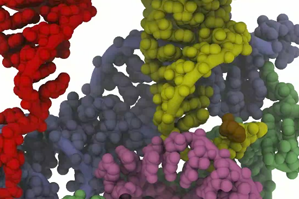Like a car engine from space

So let’s pretend that your car wasn’t built by human hands, but just kind of landed in your driveway one day, after a morning drive through outer space. You, and auto-mechanics everywhere, have no idea how it works and getting around that is made particularly difficult because you can only get under the hood when it’s not running.
These are the general circumstances that assistant professor Paul Whitford faces when trying to model the behavior of molecular machines like the ribosome, a cellular complex made out of RNA and proteins that is responsible for protein production. Using techniques like x-ray crystallography and cryo-electron microscopy, scientists have static pictures of what the ribosome looks like at particular points during its activity, but they can never look directly under the hood, so to speak.
To get around that fact, Whitford uses a few standard biophysical principles — like the fact that atoms can’t pass through one another and the fact that water molecules are constantly bombarding everything inside the cell — to generate computer models that can elucidate what’s going on in between the snapshots.
Below is a video he made a couple years ago from a study that appeared in the journal RNA, which served as the foundation for their subsequent studies appearing in Nature and Proceedings of the National Academy of Sciences. It shows exactly how one piece of the ribosome (tRNA) moves from one side of the complex to the other. The information can help drug developers make molecules that are more likely to interact and have the impact they’re going for.
It also shows just how difficult life is at that small scale. Your car engine doesn’t have to worry about things like wind disrupting its functioning, but ribosomes are always at the mercy of the surrounding environment, which is constantly in flux. The nervous tremors you’ll see are a result of those bombarding water molecules.
